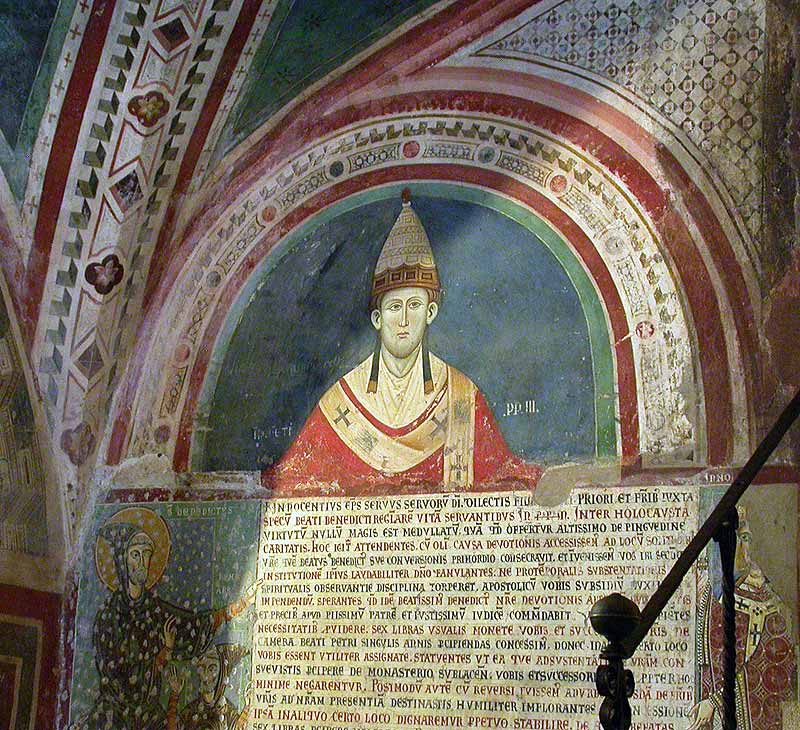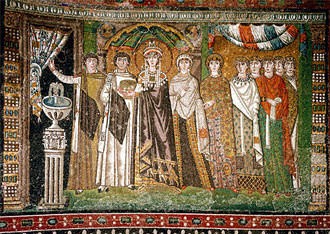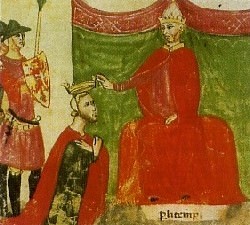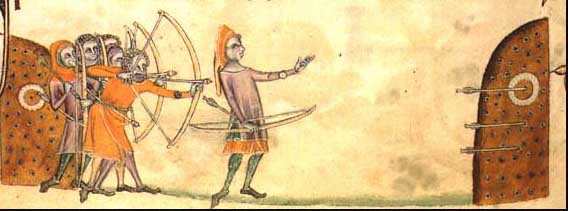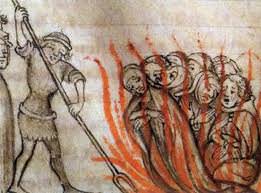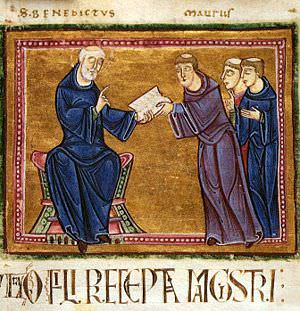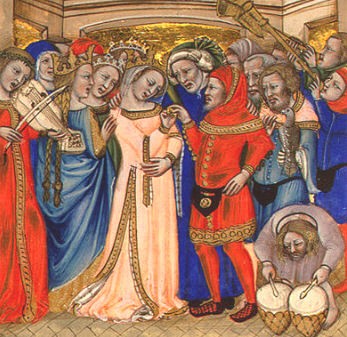Building the Ideology of Papal Monarchy Through Excommunication and Interdict: A comparison of Gregory VII and Innocent III
This thesis will examine and compare how excommunication and interdict augmented papal power during the reigns of Gregory VII and Innocent III.
Portuguese ecclesiastics and Portuguese affairs near the Spanish cardinals in the roman curia : 1213-1254
The lives, families and clienteles of Pelayo Gaitán and Gil Torres, the two cardinals whose actions I wish to analyse here (1213-1254), seem to be a good example of how instrumental, their ‘natio’ proved to be, in the management of
the affairs they were summoned to deal with.
“Those who give are not all generous”: Tips and Bribes at the Sixteenth-Century Papal Court
Ambassadors in early modern Europe were frequent disbursers of tips, rewards and bribes, and usually expected something in return for their liberality.
Medieval reads for Dad!
Father’s Day is just around the corner – here are some fun medieval reads to make his day special!
Pope Gregory X and the Crusades
Pope Gregory X’s papal tenure (September 1271 – January 1276) stood at the very
centre of the crusading movement in the later thirteenth century.
Diplomatic aspects of Charles the Bold’s relations with the Holy See
Both Paul II and Sixtus IV, the two popes whose pontificates spanned the reign of Charles the Bold, made great efforts to bring about peace among the rulers of Christendom.
The legacy of the 13th Apostle: origins of the East Christian conceptions of church and state relation
In this article I wish to query the notion that there is a single Eastern Christian religious political theory, such a one that could be stood in opposition to Catholic medieval or early modern Protestant theories of church-state relations…
University of Oxford and Vatican to digitize 1.5 million pages of historical texts
A collaboration between the University of Oxford’s Bodleian Library and the Biblioteca Apostolica Vaticana at the Vatican will bring historical texts dating back to the Middle Ages into the digital era.
St. Birgitta: The Disjunction Between Women and Ecclesiastical Power
However, if one theoretically unseats the primacy of the Papal cause and instead places its importance within the context of Birgitta’s life as a woman, a more sympathetic portrait emerges. When I re-examine her visions and her life in this light, I find that Birgitta was divided in her allegiance to the Papal Father in her concern for women.
Walking in the Shadows of the Past: The Jewish Experience of Rome in the Twelfth Century
During this pivotal century and within the special microcosm of Rome, Jews and Christians experienced unusually robust cultural and social interactions, especially as the Jews increasingly aligned themselves with the protective power of the papacy.
Martinus Polonus’ Chronicle of the Popes and Emperors: a Medieval Best-seller and its Neglected Influence on Medieval English Chronicler
In so doing I should like to begin by giving a brief account of Martin’s life and of the structure and contents of his chronicle before examining how widely known it was in late medieval England. Then we will turn to the various ways in which it was ‘adapted’, i.e. translated and extended by continuations. Finally, particular emphasis will be given to Martins hitherto neglected influence on a number of English medieval chroniclers.
Sacred Conquest and Ecclesiastical Politics: The Normans and the Church in the Eleventh Century
The Normans’ success hinged upon their ability to appear as divinely appointed rulers who served, protected, and guided the Church in the countries they held. They derived authority from the Church, and they also exercised authority over it.
Süleyman the Magnificent and the Representation of Power in the Context of Ottoman-Hapsburg-Papal Rivalry
This article explores issues of cross-cultural communication raised by the Ottoman court’s intense patronage of European artistic talent during the early part of Suleyman the Magnificent’s reign (1520-1566).
The medieval crossbow as surgical instrument: an illustrated case history
The crossbow could be carried loaded,required little training or strength,and propelled its quarrel or bolt with frightening accuracy and force for eighty yards on direct aim and double or triple that on extreme range.
The Myth of Parisian Scholars’ Opposition to the System of Papal Provision (1378–1418)
It is clear, however, that Parisian scholars did repeatedly and vehe- mently call for the suppression of Benedict XIII’s powers of papal provision. They advocated this policy as early as 1395.
Retroactive Heresy: The influence of early Christian heresies on the identification and reaction to heretical sects
The medieval Church viewed itself as Defender of the Faith, the destroyer of the unbelievers, the wrong believers. These heretics were to be reviled and feared as perverters of God’s word. The perverters of orthodoxy were, ultimately, not to be distinguished from one another, but rather known by catchphrases.
The Place of the Papacy in the Ecclesial Piety of the 11th-century Reformers
In the tenth century, it was still the Ecclesia rather than the pope which constituted the fundamental reality. The men of the Gregorian reform, in contrast, saw the Church as dependent upon the pope and derived in some way from papal power.
Corruption and Controversy: Simony, lay investiture, and clerical marriage and celibacy in the Catholic Church during the eleventh and twelfth centuries
Three major problems faced the Western church during the eleventh and twelfth centuries. Simony, lay investiture, and clerical marriage and celibacy all affected the church. They placed unnecessary power in the hands of lay rulers. They corrupted the office of the papacy to a degree. They also caused controversy throughout the church.
Popes, Bishops, Deacons, and Priests: Church Leadership in the Middle Ages
The purpose of this paper is to survey the growth of the church offices, in particular the papacy, from their biblical foundations, through to the end of the Middle Ages.
Book Review: Pope Joan, by Lawrence Durrell
Once I got past all the unnecessary narrative, this book read like a script from a ‘Carry On’ movie: a titillating tale of lusty desires and ambition set against a religious backdrop, and heavily cloaked in the guarded innuendo of the time.
The monastic response to Papal reform: Summi Magistri and it reception
This is a question which has dogged the history of the interaction between Rome and the Black monks, and it brings a second question in its wake – what were the medieval Popes trying to do with monasticism?
Theocratic Centralism: The Politics of Boniface VIII during the Thirteenth Century
This paper intends to outline how Pope Boniface VIII (1294-1303), in his struggle with King Philip IV le Bel of France (1268-1314), had an ultimate objective to create a theocratic government under which all other nations existed, essentially creating a Christian nation without borders
Hincmar and Anastasius: Lying, Treacherous Villains
Did Anastasius help kidnap and murder the wife and daughter of Pope Adrian II?
Sanctified Sex: How Familial Support of the Rule of the Church Turned the Marriage Ceremony into a Religious Rite
During the twelfth and thirteenth century, northern France underwent a subtle but dramatic change in its social power structure: the regulation of marriage fell under the power of the Church
At Arm’s Length? On Papal Legates in Normandy (11th and 12th centuries)
At Arm’s Length? On Papal Legates in Normandy (11th and 12th centuries) By Kriston Rennie Revue d’Histoire Ecclesiastique, Vol.105:2 (2010) Abstract: For the…
